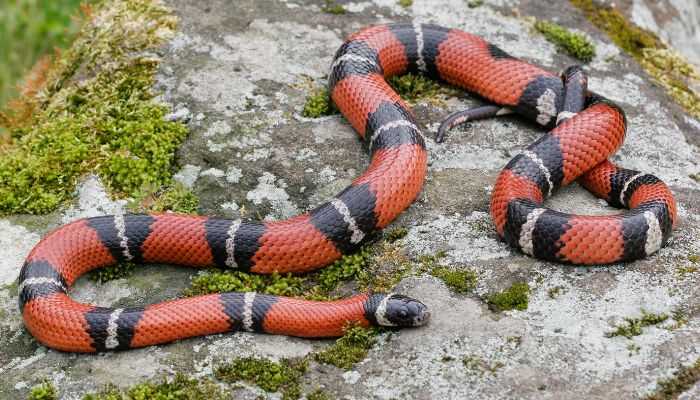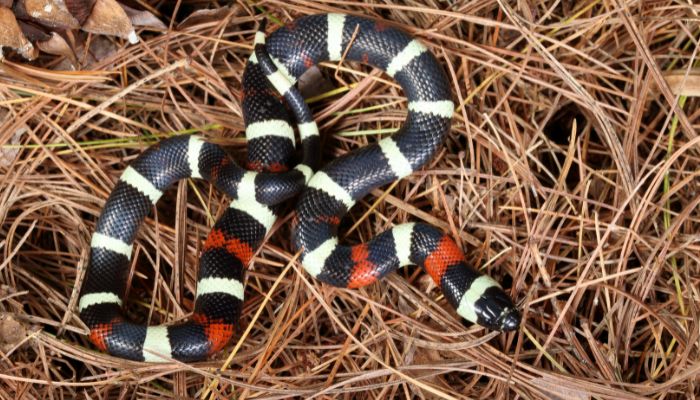Dive into the enigmatic world of milk snakes and discover the pivotal role humidity plays in their well-being. From ensuring they shed smoothly to maintaining their glossy appearance, moisture matters.
Yes, milk snakes do require humidity. Optimal humidity levels, typically between 50% and 70%, ensure healthy shedding, digestion, and overall well-being. Maintaining these levels aids in their skin health, activity, and prevents dehydration.
In this deep dive, we’ll uncover the importance of humidity for these captivating creatures, delve into the optimal levels, and provide you with hands-on tips to nail the perfect environment.
We’ll also tackle some burning questions, ensuring you’re equipped to offer your milk snake the best care possible. Ready to embark on this slippery journey?
Let’s unravel the mysteries together!

Table of Contents
The Importance of Humidity for Milk Snakes
Let’s embark on this fascinating journey into the world of milk snakes and why humidity plays such a crucial role in their life.
Skin Shedding
So, first things first: the skin shedding process. Have you ever struggled to peel off a stubborn sticker from a surface? That’s somewhat how a milk snake feels when shedding in low humidity.
The right humidity ensures a smooth and efficient shedding process. In ideal conditions, a milk snake will shed its skin in one beautiful, continuous piece. In subpar conditions? It’s like that frustrating, torn-up sticker, but with their skin!
A proper moisture level aids in loosening the old skin, making the shedding process seamless. And believe me, a smoothly shed skin is a sign of a happy and healthy snake!
Digestion and Hydration
Now, moving on to digestion and hydration. Remember the last time you felt super thirsty on a scorching day? Milk snakes, while they won’t grab a glass of water like us, heavily rely on the right humidity levels for their hydration.
A dehydrated snake can face digestive issues, making it challenging to process their meals. The proper humidity helps maintain their internal hydration levels, ensuring that digestion is a smooth sail and not a rocky road.
Overall Health and Immunity
Talking about the bigger picture – overall health and immunity. Imagine walking into a room that’s either too dry or too damp.
Neither feels comfortable, right?
Similarly, for milk snakes, the incorrect humidity can lead to respiratory issues, skin problems, and a lowered immune response. These reptiles, much like us in a spa, thrive in a balanced environment, leading to better immunity and fewer health issues.
Reproduction and Eggs: Another Humidity-Dependent Factor?
Ah, the cycle of life! Just like many aspects of their lives, reproduction, particularly the incubation of their eggs, has a strong link to humidity. Have you ever noticed how certain environments are just more conducive to relaxation and calm?
Similarly, the right humidity conditions can encourage breeding behaviors in milk snakes. Moreover, eggs require specific moisture levels to develop correctly. Too little and they might dry out; too much and there’s a risk of mold.

Humidity Levels for Milk Snakes: The Ideal Range
So, you’re now pretty sold on the idea that humidity is crucial for our slithery friends. But what’s the magic number? How humid is “humid enough”?
The Recommended Percentage
Let’s cut to the chase: for milk snakes, the recommended humidity levels typically hover between 50% and 70%. Think of this as the “Goldilocks zone” – not too dry, not too damp, but just right.
Factors Influencing These Levels
But hey, it’s not always about setting a number and forgetting it. Various factors can influence these levels. The room’s ambient humidity, the ventilation of the snake’s enclosure, and even the substrate you use can play a role.
Remember that sweltering summer day when you could practically feel the moisture in the air? Well, seasonal changes, too, can impact the humidity levels in your snake’s environment.
Differences Among Various Milk Snake Subspecies
And just when you thought you had it all figured out, here’s another twist: Not all milk snakes are created equal. Different subspecies might have slight variations in their humidity needs.
Some might prefer the lower end of the range, while others might thrive in a more humid setting. It’s like how some of us prefer a tropical beach holiday while others are mountain folks all the way!

How to Measure Humidity in a Milk Snake’s Enclosure
Now, knowing the importance of humidity is one thing, but how do you keep tabs on it? It’s not like your snake is going to tap you on the shoulder and say, “Hey, feeling a bit dry here!”
Tools Like Hygrometers
Enter the trusty hygrometer. This little device measures the amount of moisture in the air. They come in analog or digital versions, and it’s pretty much a must-have for any snake owner. Think of it as a thermostat, but for humidity!
Placement Within the Enclosure
Now, placement is key. You don’t want it too close to the heat source, or it might give a skewed reading. Ideally, place the hygrometer in the middle of the enclosure or at a level where your snake spends most of its time.
Imagine placing a thermometer next to a heater; it wouldn’t give an accurate room temperature, right? Same logic!
The Importance of Regular Monitoring
Just having a hygrometer isn’t enough. Regular monitoring is crucial. It’s a bit like checking your plants to see if they need water.
By keeping a consistent eye on the humidity levels, you can make adjustments as needed, ensuring your milk snake lives its best, most moisturized life.

Tips to Maintain the Right Humidity Levels
Now that we’ve got a handle on measuring humidity, let’s get into the nitty-gritty of maintaining those prime moisture levels. And trust me, it’s easier than you think!
Using Misters or Damp Moss
Have you ever walked through a misty forest, feeling the tiny droplets caress your face? That’s the vibe you’re going for, but for your milk snake. Misters can be a lifesaver, especially when the air gets a tad too dry.
And if misters seem too high-tech for your taste, going old school with damp moss works wonders too. Simply sprinkle some in the enclosure, and voilà – instant humidity boost!
The Role of Substrates in Retaining Moisture
Substrates aren’t just for looks; they’re the unsung heroes in the humidity game. Some substrates, like cypress mulch or coconut coir, are champs at retaining moisture.
They act like sponges, holding onto water and slowly releasing it, creating a stable environment. It’s a bit like choosing the right carpet – some just feel plushier and more comfortable underfoot.
Proper Tank Ventilation
But remember, it’s not just about adding moisture. Proper tank ventilation ensures there’s a balance. It prevents the environment from becoming too stagnant or overly damp.
Think of it as airing out a room; sometimes, you need a fresh breeze to make everything feel just right.

Signs Your Milk Snake Needs More Humidity
Okay, so you’ve got the setup, but how do you know when your milk snake is silently shouting, “I need more moisture!”? Let’s decode the signs.
Difficulty in Shedding
Shedding issues are the first big red flag. If your snake is leaving behind patchy, torn pieces of skin or seems to be struggling with the process, it’s practically screaming for more humidity.
Lethargy or Decreased Activity
Picture yourself on a day when you’re feeling super dehydrated. All you want to do is lay down and rest, right? Milk snakes are the same. If they’re not getting enough humidity, they might show signs of lethargy or decreased activity.
It’s their way of conserving energy.
Changes in Skin Appearance
A milk snake’s skin should be vibrant and smooth. But when the humidity drops, it might appear dull or even slightly wrinkled. It’s a bit like us getting dry skin during the winter months.
Behavioral Changes Indicating Humidity Issues
Lastly, pay attention to any odd behavior. Maybe your snake is spending more time in its water dish or burrowing deep into the substrate. These could be sneaky signs it’s trying to find more moisture.

Potential Risks of Incorrect Humidity Levels
Just as to how we humans can face health issues in an environment that’s too damp or too dry, milk snakes face their own set of challenges when their living conditions aren’t up to snuff.
Respiratory Infections
First on our list: respiratory infections. Think about how you might feel in a room that’s too humid. That sticky, heavy air? It’s a breeding ground for bacteria and molds. The same goes for a milk snake’s enclosure.
Too much humidity can lead to respiratory infections. Imagine your snake wheezing or having mucus in its mouth – it’s as distressing as it sounds.
Skin Disorders
Next up, skin disorders. A milk snake’s skin isn’t just there to look pretty. It’s its primary barrier against the outside world. Now, if the humidity is too high, the skin can become too soft and susceptible to infections. On the flip side, too low, and it can crack or become irritated. It’s akin to how our skin can either get super oily or overly dry, depending on the environment.
Dehydration
And last but by no means least, dehydration. This might sound counterintuitive. I mean, how can a snake become dehydrated in a humid environment?
But if the humidity is too low, your milk snake might lose more moisture than it takes in, leading to dehydration. Think parched lips on a dry winter day, but for snakes.
Summary
You’ve journeyed through the intricate world of milk snakes and the vital role humidity plays in their lives. From aiding in shedding to boosting their overall health, it’s clear that maintaining the right moisture balance is paramount.
Equipped with this knowledge, you’re now poised to offer optimal care for your slithery friend. Remember, with a bit of attention and dedication, you can ensure your milk snake thrives in a comfortable environment.
Here’s to happy, healthy snakes and confident caregivers like you!
FAQ
Ah, the world of milk snakes is filled with questions, isn’t it? No worries! Here’s a rapid-fire round to quench your burning curiosity.
Do Milk Snakes need a humidity box?
Absolutely! A humidity box, often filled with damp moss or a similar substrate, provides a micro-environment where your snake can go when it needs an extra boost of moisture, especially during shedding times.
Do Milk Snakes need to be misted?
Yes, they do. Misting helps maintain the ideal humidity levels in their enclosures. It’s like giving them a mini rain shower, which can be particularly beneficial in drier climates or seasons.
How do I create humidity for my snake?
Several ways! Use damp moss, misting, or a humidity box. Also, the choice of substrate can play a significant role in retaining moisture. Some folks even place a water dish near the heat source to increase evaporation and thus, humidity.
Do Milk Snakes need a heat lamp?
They sure do. While this isn’t directly related to humidity, heat lamps ensure your snake has a proper temperature gradient in its enclosure. It helps in digestion and overall well-being. Just make sure it doesn’t make the environment too dry!




0 Comments